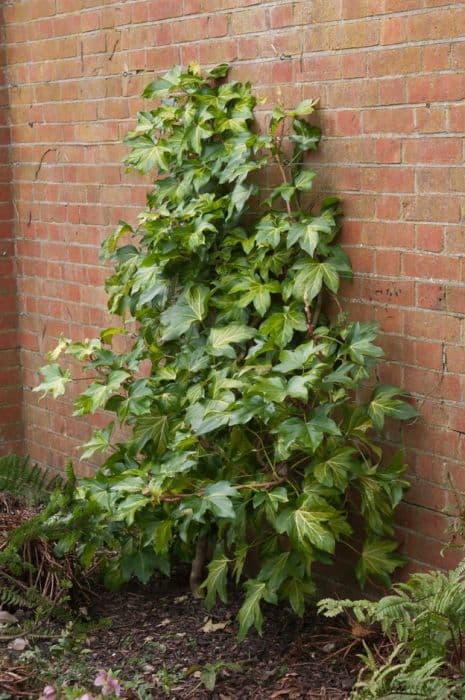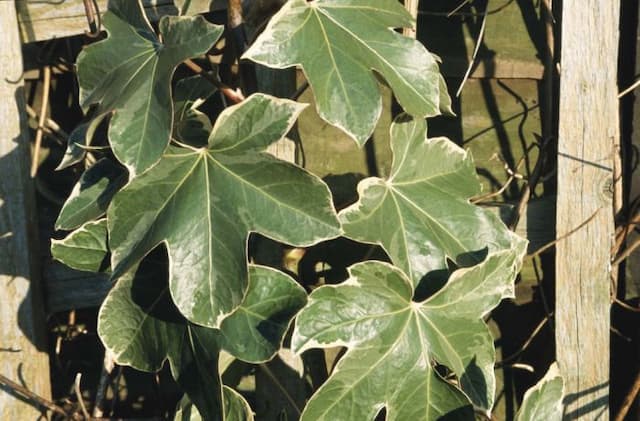Golden Japanese Aralia Aralia elata 'Aureovariegata' (v)

ABOUT
Aralia elata 'Aureovariegata', commonly known as the variegated Japanese angelica tree, is a striking ornamental plant. Known for its beautiful foliage, the leaves of this variety are large and doubly compound, meaning that they are divided multiple times into smaller leaflets, creating a very lacy and delicate appearance. The most captivating feature of the 'Aureovariegata' is its variegated leaves that display a tapestry of green marked with splashes or edges of creamy-yellow to bright gold, bringing a luminous quality to the plant's overall appearance. As the seasons change, the foliage transforms, with the leaves typically developing a more yellowish hue as they mature. Before the leaves emerge, the plant can produce large, showy panicles of tiny white flowers that add a subtle but fragrant touch to the display. Following the flowering period, the plant may produce small, dark berries, which offer a stark contrast to the foliage and can attract birds. The bark of the variegated Japanese angelica tree is also noteworthy, displaying an interesting texture that can add to the plant's visual interest even in the absence of leaves. The overall visual effect of the Aralia elata 'Aureovariegata' is of a lively, textured plant that can brighten up any garden space with its striking variegated foliage.
About this plant
 Names
NamesSynonyms
Golden Japanese Aralia, Variegated Japanese Angelica Tree.
Common names
Aralia elata 'Aureovariegata' (v).
 Toxicity
ToxicityTo humans
The Japanese angelica tree or Aralia elata 'Aureovariegata' is not commonly listed as a toxic plant to humans. However, it's essential to be cautious as different people can have varying sensitivities to plants. If a person ingests a part of the plant and experiences symptoms such as stomach upset, vomiting, or diarrhea, they should seek medical advice.
To pets
The Japanese angelica tree or Aralia elata 'Aureovariegata' is not commonly listed as a toxic plant to pets. However, as with humans, individual animals might have specific sensitivities. If a pet shows signs of illness after ingestion, such as vomiting, diarrhea, or changes in behavior, it is important to contact a veterinarian.
 Characteristics
CharacteristicsLife cycle
Perennials
Foliage type
Deciduous
Color of leaves
Variegated
Flower color
White
Height
6-10 feet (1.8-3 meters)
Spread
6-8 feet (1.8-2.4 meters)
Plant type
Shrub
Hardiness zones
4
Native area
Asia
Benefits
 General Benefits
General Benefits- Ornamental Appeal: The 'Aureovariegata' variety of the Japanese Angelica Tree has variegated foliage, adding a splash of color contrast to gardens with its yellow and green leaves.
- Landscape Diversity: It contributes to biodiversity by providing a unique visual element distinct from common green-only plants.
- Shade Provider: As the Japanese Angelica Tree matures, it can provide a significant amount of shade due to its size and leaf density.
- Habitat for Wildlife: Birds and other wildlife may use the tree for nesting and as a food source, particularly enjoying its berries.
- Height Interest: It can grow to be quite tall, which creates vertical interest in a landscape design and can be used as a focal point.
- Seasonal Interest: In addition to its variegated leaves, the tree blooms with attractive clusters of white flowers in the summer, followed by purplish-black berries, offering year-round visual appeal.
- Durability: It is relatively tough and can withstand urban environments, making it suitable for city landscaping.
- Windbreak: When planted in groups, this tree can act as a windbreak to protect gardens and buildings from strong winds.
- Privacy Screen: Dense foliage makes the Japanese Angelica Tree effective as a privacy screen, blocking unwanted views and creating a sense of seclusion.
 Medical Properties
Medical Properties- This plant is not used for medical purposes.
 Air-purifying Qualities
Air-purifying QualitiesThis plant is not specifically known for air purifying qualities.
 Other Uses
Other Uses- Culinary Ingredient: Young shoots of Japanese angelica tree are edible and can be blanched and used in salads or fried in tempura.
- Dye Production: The bark of Japanese angelica tree can be used to produce tannin for natural dyes, suitable for coloring fabrics or crafting materials.
- Woodworking: The wood of the Japanese angelica tree is sometimes used in fine woodworking for small projects like turned bowls or decorative items due to its interesting grain.
- Windbreaks: In gardens, Japanese angelica tree can be planted to create a visual barrier or to protect other plants from strong winds due to its robust nature.
- Fauna Habitat: The tree provides shelter and breeding ground for various bird species, enhancing local biodiversity.
- Sculpture Material: Larger branches and trunks can be carved into artistic sculptures or used in the creation of unique garden features.
- Privacy Screening: Dense foliage makes the Japanese angelica tree an excellent natural screen for privacy in residential landscaping.
- Ritual Uses: In some cultures, parts of the tree may be used in traditional ceremonies or as symbolic objects reflecting nature's power and beauty.
- Education: Used as a specimen in educational institutions for botany students to study variegation and the adaptation of plants to different light conditions.
- Photography: The variegated foliage and stature of the Japanese angelica tree provide interesting subjects for nature and garden photography.
Interesting Facts
 Feng Shui
Feng ShuiThe Japanese angelica tree is not used in Feng Shui practice.
 Zodiac Sign Compitability
Zodiac Sign CompitabilityThe Japanese angelica tree is not used in astrology practice.
 Plant Symbolism
Plant Symbolism- Resilience - The Japanese angelica tree often thrives in challenging conditions, symbolizing the capacity to endure and adapt.
- Growth and Vitality - Its vigorous nature and rapid growth reflect a symbol of life and energetic expansion.
- Protection - The spiny stems of the tree can represent a protective barrier against negativity or harm.
- Elevation - The height and upward growth of the tree can symbolize reaching towards higher goals or spiritual ascension.
 Water
WaterThe Japanese angelica tree, or Japanese Aralia, thrives when watered thoroughly once the top inch of soil feels dry to the touch. Typically, this might mean watering every one to two weeks, depending on the environmental conditions. During active growth in the spring and summer, water the plant with approximately 1-2 gallons, depending on the size of the pot, making sure excess water drains out of the bottom. Reduce watering in the fall and winter to prevent root rot, providing enough to keep the soil slightly moist. Always use room temperature water to avoid shocking the plant's roots.
 Light
LightThe Japanese angelica tree prefers bright, indirect light and should be placed in a spot that receives this type of light for most of the day. Direct sunlight can scorch the leaves, so it's best to avoid placing it in south-facing windows without some form of shade. An east or west-facing window with filtered light is typically ideal for this plant to thrive.
 Temperature
TemperatureIdeal temperature conditions for the Japanese angelica tree are between 60°F and 80°F, which mimic its natural environment. It can handle a brief dip down to around 50°F but shouldn't be exposed to temperatures lower than that for extended periods. It prefers to avoid drastic temperature changes and should be kept away from drafts and vents.
 Pruning
PruningPrune the Japanese angelica tree to maintain its shape and encourage bushier growth. The best time for pruning is in the late winter or early spring before new growth begins. Remove any dead or damaged branches and thin out areas that are overly dense. Pruning can be done annually or as needed to control the size of the plant.
 Cleaning
CleaningAs needed
 Soil
SoilThe best soil mix for the Japanese angelica tree (Aralia elata 'Aureovariegata') is a well-draining soil with peat, perlite, and organic matter. The soil pH should be slightly acidic to neutral, ranging from 6.0 to 7.5.
 Repotting
RepottingJapanese angelica trees should be repotted every 2-3 years to prevent root-bound conditions and to replenish nutrients in the soil.
 Humidity & Misting
Humidity & MistingJapanese angelica trees thrive in moderate to high humidity levels, ideally between 40-60%.
 Suitable locations
Suitable locationsIndoor
Provide bright, indirect light and keep well-drained.
Outdoor
Plant in well-draining soil, partial shade to full sun.
Hardiness zone
4-9 USDA
 Life cycle
Life cycleThe Japanese angelica tree (Aralia elata 'Aureovariegata') begins its life cycle when the seeds are dispersed by wind or animals, germinating in spring under suitable conditions of moisture and temperature. Seedlings establish themselves and grow into juvenile plants with characteristic variegated foliage, which can take several years to mature. The mature plant then reaches its reproductive phase, producing clusters of white flowers in the summer, which are attractive to pollinators such as bees. Following pollination, the flowers develop into small, dark berries that are eaten by birds, facilitating seed dispersal. This perennial plant continues to grow and can reach considerable size, with some specimens living for many decades. It undergoes annual cycles of dormancy in the winter and reemergence of foliage and flowers in the spring.
 Propogation
PropogationPropogation time
Late winter
Propogation: The Japanese angelica tree 'Aureovariegata' is a variegated cultivar of Aralia elata that can be propagated through softwood cuttings, a technique typically undertaken in late spring to early summer when new growth is supple and has not yet hardened. To propagate from cuttings, a gardener should select a healthy shoot and cut a 4 to 6 inch (approximately 10 to 15 cm) length, ensuring there are at least two sets of leaves. The lower leaves are removed, and the cut end is dipped in rooting hormone to encourage root development. This cutting is then placed in a well-draining potting mix and kept moist under indirect light until roots have established, which often requires several weeks. A plastic cover or bag can be used to maintain humidity around the cutting, improving the odds for successful rooting.









